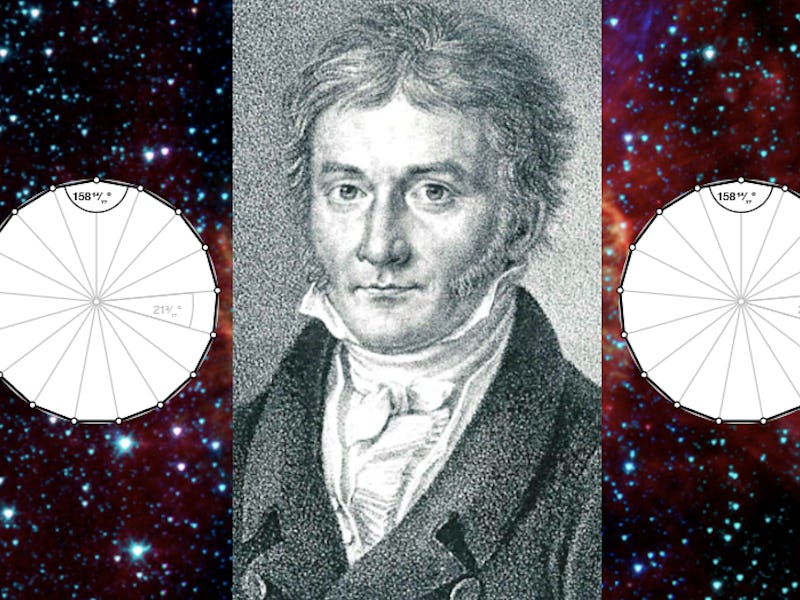From Space to Shapes: 5 Cosmic Discoveries by Johann Carl Friedrich Gauß
This guy did it all.

Math can be used to do a lot of things. Johann Carl Friedrich Gauß, the German mathematician and physicist, understood this very well. On Monday, Google commemorated Gauß with a Google Doodle for his contributions across a wide spectrum of fields during his existence on Earth from 1777 and 1855.
A gifted thinker who could rattle off complex equations in his head at the age of seven, Gauß’s discoveries changed the way we approach space, science, and geometry. Here are a just a few of his most interesting accomplishments.
A regular heptadecagon with annotation. Try saying heptadecagon three times fast.
5. The Heptadecagon
At the ripe young age of 19, Gauß discovered how to construct a 17-sided polygon using only a ruler and a compass in 1796. Called a heptadecagon, it was the first progress in polygon construction since the ancient Greeks over 2,000 years prior. Gauß used algebra to prove his construction, bridging a crucial gap between algebra and geometry.
4. The Orbit of Ceres
Originally discovered by the astronomer Giuseppe Piazzi in 1800, the asteroid had vanished behind the sun before astronomers could calculate its orbit. Gauß developed a model called the method of least squares — a way of calculating for errors in observation. It’s still the go-to method to find an accurate relationship between two variables. The Ceres discovery propelled Gauß into a long stint of working as an astronomer; he became the professor of astronomy at astronomical observatory in Gottingen.
3. Theory of the Motion of
In 1809 Gauß published a two-volume treatise on the movement of celestial bodies in space. Called Theoria motus corporum coelestium in sectionibus conicis solem ambientum (theory of motion of the celestial bodies moving in conic sections around the sun), the work describes the motion of asteroids that have been disturbed by large planets. “In the process of his investigation, he so streamlined the cumbersome mathematics of eighteenth century orbital prediction that his work remains a cornerstone of astronomical computation,” writes [the New World Encyclopedia.](http://www.newworldencyclopedia.org/entry/Johann_Carl_Friedrich_Gauss#Telegraph
2. The First Telegraph Line
Perhaps not his most famous invention but definitely still interesting, in 1833 Gauß and the physics professor Wilhelm Weber created the first electromagnetic telegraph. The two had been collaborating on discoveries in the field of magnetism at the University of Gottingen, and they constructed the telegraph to connect between the observatory with and institute for physics. The system was capable of sending eight words a minute.
The heliotrope being used by a U.S. surveyor, estimated to be from around 1878.
1. The Heliotrope
From 1818 to 1832, Gauß embarked on a geodetic survey of the state of Hanover. It was during this time that he invented the heliotrope, an instrument that greatly improved long distance land surveys. The heliotrope uses a mirror to reflect sunlight over a far distance — we’re talking hundreds of miles — marking positions for surveyors. Unfortunately, the instrument worked best on sunny days, and in the 1980s GPS technology replaced it.